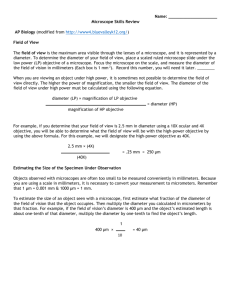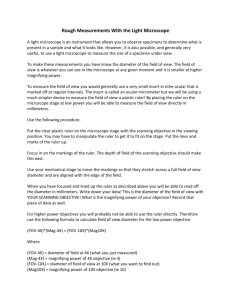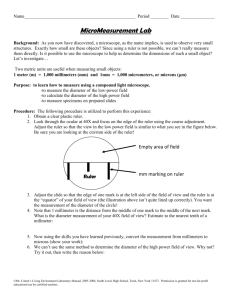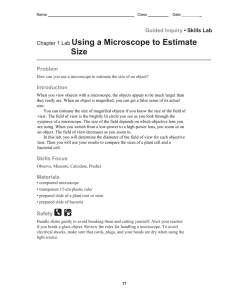Name
advertisement
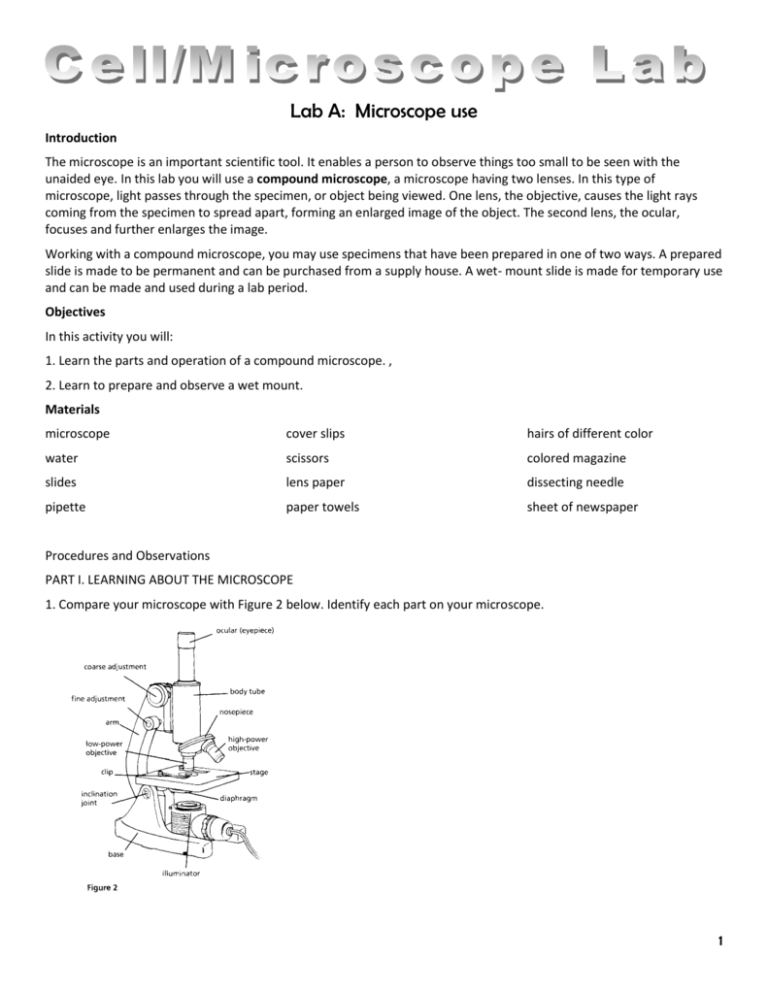
Lab A: Microscope use Introduction The microscope is an important scientific tool. It enables a person to observe things too small to be seen with the unaided eye. In this lab you will use a compound microscope, a microscope having two lenses. In this type of microscope, light passes through the specimen, or object being viewed. One lens, the objective, causes the light rays coming from the specimen to spread apart, forming an enlarged image of the object. The second lens, the ocular, focuses and further enlarges the image. Working with a compound microscope, you may use specimens that have been prepared in one of two ways. A prepared slide is made to be permanent and can be purchased from a supply house. A wet- mount slide is made for temporary use and can be made and used during a lab period. Objectives In this activity you will: 1. Learn the parts and operation of a compound microscope. , 2. Learn to prepare and observe a wet mount. Materials microscope cover slips hairs of different color water scissors colored magazine slides lens paper dissecting needle pipette paper towels sheet of newspaper Procedures and Observations PART I. LEARNING ABOUT THE MICROSCOPE 1. Compare your microscope with Figure 2 below. Identify each part on your microscope. 1 2. Examine the diaphragm. Adjust it to the largest opening so that the most light enters the microscope. You can tell this by looking through the ocular. 3. While looking at your microscope from the side, slowly turn the coarse adjustment one-half turn toward you. A. In which direction does the stage move? 4. Continue to turn the coarse adjustment until the low power objective is about 3 cm from the stage. The low power objective is the shorter, or the shortest, objective. 5. Look at the number followed by an “X” on the side of each objective or the number after DIN. This number is the objective’s magnifying power. The “X” stands for “times.” Thus the number tells how many times an object is magnified by this lens. B. What is the magnifying power of the lowest-power objective? 6. Locate the high-power objective. C. What is its magnifying power? D. What is the magnifying power of the objectives between the high and low power objectives? 7. If the lenses look dirty or smudged, carefully wipe them with lens paper. Use only lens paper because other kinds of paper can damage the lenses. The ocular lens also has a magnifying power. The total magnifying power of the microscope is easy to calculate. Simply multiply the magnifying power of the ocular by the magnifying power of the objective. For example, if the ocular is 5X and the objective is lOX, the total magnification of the object being viewed is 5X x lOX = 50X. 8. Examine the ocular lens. E. What is its magnifying power? F. What is the total magnification produced when the low-power objective is used? Show your calculations. G. What is the total magnification produced when the high-power objective is used? Show your calculations. H. What is the total magnification of the lenses in between high and low? Show your calculations. PART II. PREPARING AND EXAMINING A WET MOUNT Find a small lowercase letter “e” in a piece of newspaper and cut it out. 1. Place the letter in the middle of a clean slide. With a pipette, put 1 drop of water on the square. Drop the water from about 1 cm above the slide. Do not touch the pipette to the paper or the paper will stick to the pipette. 2. Now cover the mount with a clean cover slip. One way to do this is shown in Figure 3-a. Hold the cover slip at about a 45° angle to the slide and move it toward the drop. As the water touches the cover slip, it will spread along the edge. Gently lower the cover slip into place. Do not press on the cover slip—it should rest on the top of the water. A good wet mount is free of bubbles. If your mount has too many bubbles, take off the cover slip and absorb the water with a paper towel. Then repeat Steps 2 and 3. 2 3. Click the low-power objective into place. Make sure you have a good light source and that the diaphragm is at the largest opening. 4. Check to be sure the bottom of the slide is dry before placing it on the stage of the microscope. Set it on the stage so that the “e” is in reading position (when you look at the e on the slide it is right-side-up) and over the hole in the stage. Hold the slide in place with stage clips. 5. Look at the microscope from the side. Use the coarse adjustment knob raise the stage until the objective is about 1/2 to 1 cm above the slide, or until you feel an automatic stop. 6. Look through the ocular, keeping both eyes open. Keeping both eyes open is difficult at first, but it helps to prevent eyestrain. It will become easier with practice. 7. Slowly lower the stage by turning the coarse adjustment until the letters come into focus. Use the fine adjustment to sharpen the focus. Observe the letter “e.” A. The space on your answer sheet (like the one below) represents your field of view. This is the lit circle you observe when looking through the ocular. Draw the letter “e” the same size and in exactly the same position as you see it through the microscope. 8. Move the slide to the left. B. Which way does the image move? 9. Move the slide to the right. C. Which way does the image move? 10. Move the slide away from you. D. Which way does the image move? 11. Observe the wet mount as you change the diaphragm to each of its settings. Adjust it to give good contrast and illumination without glare. E. What does the diaphragm control? Before using high power, the specimen must be in sharp focus in the center of the low-power field of view. Note: All focusing under high power is done with the fine adjustment knobs. There is no automatic stop for the high-power objective. 12. Watching from the side, carefully switch to the medium power objective. Center the object and focus. 13. Now without changing anything, switch to the high-power objective. Make sure that the objective does not hit the slide, but expect it to be very close. 14. Focus on the letter “e.” Only a slight turn of the fine adjustment knob will be needed to do this. F. In the space on your answer sheet, draw the letter “e” exactly as you see it under high power. 3 G. Is the field of view (how much area you see) larger under high power or low power? H. Compare the brightness of the field under high power and low power. PART III. RESOLVING POWER AND DEPTH OF FIELD 1. Make a wet mount using a 1-cm square of a colored newspaper cartoon or a colored picture from a magazine printed on thin paper. Choose a square that has both light and dark tones, but not black. A. Record the colors of the square. Resolving power is the ability to distinguish between two separate points that are very close together. Microscopes have a resolving power greater than that of the human eye. 2. Observe the slide under low power. Then switch to high power. Examine the light and dark areas of the square. B. How is the color distributed? c. What colors do you see under high power? The depth of field is the distance above the slide in which the object is in good focus. 3. Prepare another wet mount, this time using two hairs of different colors. Cross them on the slide, then add a drop of water and the cover slip. 4. View the slide under low power. Focus directly on the point where the hairs cross. D Are both hairs in focus under low power? 5. Switch to high power and observe the hairs. E. Are both hairs in focus under high power? Explain. Analysis and Interpretations 1. Briefly describe the function of each of the microscope parts listed below. Part ocular stage clips coarse adjustment diaphragm nosepiece illuminator objectives fine adjustment stage 2. Why should a wet mount have no bubbles? 3. What did the microscope do to the image of the letter “e”? 4. Why must you center and focus the object in the field of view under low power before switching to high power? 5. Why is only the fine adjustment used for high power? 6. By using the idea of depth of field, how can you tell which hair was above the other? 8. If you were scanning a slide to find a particular area, which objective would be better to use? Why? 4 Lab B: Measuring with the Microscope Background It is interesting and informative to observe specimens under the microscope, but it is often difficult to know the actual size of the object being observed. Magnification causes us to lose the idea of actual size. You cannot hold a ruler up to a paramecium or a plant cell while it is under a microscope. Therefore, size must be measured indirectly—that is, it must be compared with the size of something you already know. The diameter of the microscope field seen through the ocular is a convenient standard to use. Two metric units are useful when measuring small objects: 1 meter (m) = 1000 millimeters (mm) 1 mm = 1000 micrometers (μ m) Objectives In this activity you will: 1. Measure the diameter of the low-power field. 2. Calculate the diameter of the high-power field. 3. Learn how to estimate the sizes of objects under the microscope. Materials microscope transparent metric ruler prepared slide of corn (Zea) stem prepared slide of paramecium Procedures and Observations 1. Examine the markings on a transparent metric ruler. Determine which marks indicate millimeter lengths. Then place the ruler on the stage so that it covers half of the stage opening as shown in Figure 1. 2. Prepare your microscope for low-power observation of the ruler. 5 3. Look through the ocular. Focus on the edge of the ruler, using the coarse adjustment. Adjust the position of the ruler so that the view in the low-power field is similar to 4. Place the center of one mark at the left side of the field of view. Make sure that the edge of the ruler is exactly across the center of the field. If the ruler sticks to your fingers, use the eraser end of a pencil to arrange it. 5. Note that 1 millimeter is the distance from the middle of one mark to the middle of the next mark. The diameter of the low-power field measures 3 millimeter plus a fraction of another. A. Record the measurement of the low-power field diameter in millimeters, expressing the length to the nearest tenth of a millimeter. 6. Convert the measurement in millimeters to micrometers by multiplying by 1000. B. Record the measurement of the low-power field diameter in micrometers. You cannot measure the diameter of the high-power field using the process you have just completed. Viewing a ruler under high power presents light and focusing problems. Also, the high-power field diameter is less than 1 millimeter. But you can indirectly obtain the high-power field diameter. You know the low-power field diameter and the magnifying power of both objectives. The magnification of the objectives is inversely proportional to the field size. You can use this formula: 7. Substitute the values you know in this formula to calculate the high-power field diameter. C. Record the high-power field diameter in micrometers. Show your calculations. The measurements of the low-power and high-power field diameters can be used to measure other things indirectly. 8. Under low power, focus on a prepared cross section of corn stem. The center of a corn stem is filled with large, thin-walled cells. These are pith cells. They look a pale blue color. 6 9. Observe the pith cells. D. How many pith cells fit across the diameter of the low-power field? 10. To calculate the diameter of a pith cell, divide the diameter of the low-power field by the number of cells given for Question 9 E. Record the diameter of a pith cell in micrometers. 11. Switch to high power and focus with the fine adjustment. F. How many pith cells would fit across the diameter of the high- power field? 12. To calculate the diameter of a pith cell as seen under high power, divide the diameter of the high-power field by the number of cells given for Question 11 G. Record the diameter of a pith cell in micrometers, as measured under high power. Compare the measurement of the diameter of a cell under low and high power. 13. Observe a paramecium on a prepared slide under low power. Estimate its length by comparing it to the diameter of the low power field. H. Record the length of the paramecium in micrometers. 14. Switch to high power. Estimate the length of the paramecium by comparing it to the diameter of the high-power field. I. Record the length of the paramecium in micrometers as measured under high power. Analysis and Interpretations 1. Find the diameter of the high-power field of a microscope with an ocular marked lOX, a low-power objective marked 1OX, a high-power objective marked 40X, and a low-power field diameter of 1600 micrometers. Lab C: How Plant and Animal Cells Differ Introduction Although plant and animal cells have many structures in common, they also have basic differences. Plant cells have a rigid cell wall, and if they are green, they also have chloroplasts. Animal cells lack both a cell wall and chloroplasts. They also lack the central vacuole common to plant cells. You will observe and compare animal cells and plant cells. You will first examine epithelial cells from the inside of your cheek. Epithelium is a type of tissue that covers the surfaces of many organs and cavities of the body. You will then examine cells from a leaf of the freshwater plant elodea. Elodea is often used in home fish tanks. The cells of this plant are green because they contain the pigment, chlorophyll. Chlorophyll, which is found in chloroplasts within each cell, enables plants to manufacture their own food. Objectives In this activity you will: 1. Observe human epithelial cells. 2. Observe elodea cells. 7 3. Describe the differences between animal cells and plant cells. Materials microscope forceps cover slips pipette in dropper bottle slides toothpick elodea Lugol’s iodine solution methylene blue stain water Procedures and Observations PART I. HUMAN EPITHELIAL CELLS 1. Place a SMALL drop of water on a clean slide. Obtain epithelial cells by gently scraping the inside of your cheek with a clean toothpick as shown in Figure 1. CAUTION: Never reuse a toothpick or put any thing in your mouth which may not be clean. Stir the material from the toothpick in the drop of water on the slide. Then immediately break the toothpick in half and throw it away. 2. Allow the cheek cells to dry and heat fix the slide by quickly passing the slide through the flame 4-5 times. Add a small drop of methylene blue stain to the slide. CAUTION: Stain can damage clothing and discolor skin. Let the stain sit for 1 minute and then rinse the stain off the slide. Carefully place a cover slip on the slide. Examine the slide under low power. When you find some cells that are separate from each other, examine them under high power. Recall that you may have to adjust the diaphragm to reduce the intensity of the light. a. Make a drawing of two or three cells as they appear under high power. Label the nucleus, nuclear membrane, cytoplasm, and cell membrane of one of the cells. Indicate the total magnification below the circle b. What is the shape of the cells? c. Describe the appearance of the cytoplasm. 8 PART II. ELODEA LEAF CELLS 1. Break off a small leaf near the tip of an elodea plant. With a forceps place the entire leaf in a drop of water on a clean slide. Add a cover slip. See Figure 2. 2. Examine the leaf under low power. a. What is the shape of the cells? The boundary that you see around each cell is the cell wall. The numerous small, green bodies in the cells are the chloroplasts. 3. Look for an area in the leaf where you can see the cells most clearly. Examine these cells under high power, carefully focusing up and down with the fine adjustment. b. Describe the shape and location of the chloroplasts. 4. As you examine the cells, you may see the chloroplasts moving around. If they are not moving, warm the slide in your hand or under a bright lamp for a few minutes. Do not allow the slide to dry out. Then examine again under high power. c. Describe how the chloroplasts move in a cell. d. Make a drawing of an elodea cell. Label the cell wall, chloroplasts, and any other structures you see. Be sure to indicate the total magnification. 9 The cell membrane is pressed tightly against the inside of the cell wall and is difficult to see. Furthermore, the numerous chloroplasts often make it difficult to observe other cell structures in the elodea leaf cells. In order to see the nucleus, nucleoli, and vacuole more clearly, you are going to use a stain. 6. Break off another elodea leaf and place it in a drop of Lugol’s iodine solution on a clean slide. Add a cover slip. Wait a minute or so for the stain to penetrate into the cells. Then examine the stained elodea cells under low and high power. e. Make a drawing of a stained cell. Label the cell wall, cell membrane (if visible), chloroplasts, nucleus, nucleolus, and the large vacuole. Be sure to indicate the total magnification. f. What structures can you see more clearly after staining? Analysis and Interpretations 1. What structures do human epithelial cells have in common with elodea cells? 2. How do human epithelial cells and elodea cells differ? 3. Some of the epithelial cells are folded or wrinkled. What does this tell you about the thickness of the cells? 4. Chloroplasts cannot move on their own. How do you think they move around the cell? 5. What does Lugol’s iodine stain do to the activity of the cell? 10


